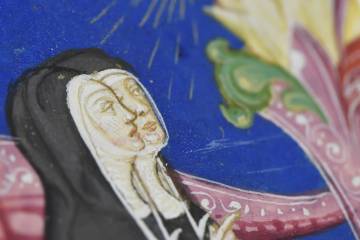Levitators. Healers. Mystics. Scholars. Diplomats.
These descriptors detail the lives of those featured in the Women of the Book collection, selections from which are now on display at the George Peabody Library's exhibit gallery through January 2023.
"The Women of the Book collection tells us, more than any single source in the world, what it was like to be a woman 500 years ago, 400 years ago, 300 years ago," says Earle Havens, the Nancy H. Hall Curator of Rare Books and Manuscripts and director of the Virginia Fox Stern Center for the History of the Book in the Renaissance at the Johns Hopkins Sheridan Libraries.
"We have a special angle, in a way, because women who were nuns, women who took vows of chastity, poverty, and obedience, also had access to education and printing presses. They lived these remarkable, imaginative, scholarly, intellectual, cultural lives," Havens says, referencing that this collection, which now tallies almost 1,000 volumes from 1450 to 1800, predominantly contains the works and possessions of Roman Catholic nuns.
Focusing on spiritual and religious life as an overall theme, some authors wrote personal remembrances or cataloged convent residents while others created unique book amulets and shrines. Artists hand-painted intricate illustrations that accompany the texts.
"We learn so much about women in general from this collection. You have examples of laywomen who are also engaging with this material, but you also see the influence of other female artistic practices like embroidery," says Kelsey Champagne, co-curator of the exhibit and a postdoctoral fellow in early modern book history at the Stern Center.
"We learn that they were makers, that they embraced sorority, that they craved community, and that they were incredibly spiritually fruitful. And we see immense creativity and beauty," she says, adding that the Women of the Book collection not only helps illustrate the autonomy of these nuns in terms of their own intellectual endeavors, but also provokes conversation about gender dynamics and the roles of women in society even today.
Champagne was first introduced to curatorial work as a Johns Hopkins freshman when she enrolled in a seminar led by Elizabeth Patton, a senior lecturer at the Alexander Grass Humanities Institute; Havens was a guest speaker in the class. After graduating from the Krieger School of Arts and Sciences in 2015 and then earning a PhD from Yale, Champagne returned to Hopkins as a Stern Center fellow, an opportunity that allowed her to become more involved with this exhibit and bring these women's voices to light.
"This fellowship brings young scholars into the curatorial field and is a way to infuse curatorial work with more rigorous scholarship," she says, explaining while this postdoc is specifically curatorial, it also involves teaching with the collections and mentoring other graduate students interested in the field.
When instructing his own students, Havens says he emphasizes that so many rare books have never been studied. So, as he places such books into students' hands, he likes to point out, "No one has ever published anything about this. Why don't you be the first person to take a crack at it?"
In addition to the fellowship and Havens' curatorship, philanthropy has played a key role in not only acquiring these rare books, but also in disseminating their contents. In fact, 85% of the Women of the Book collection has now been digitized and is available online thanks to a grant from Arcadia, a charitable fund of Lisbet Rausing and Peter Baldwin.
And the exhibit itself was made possible by Sheridan Society members of the Friends of the Johns Hopkins University Libraries, and an opening reception on October 2 was funded by the organization. This event featured a performance by Paula Maust and Grace Srinivasan of Musica Spira, an ensemble of Peabody Institute graduates that focuses on early modern women composers.
"This exhibit is important because rare books, when they're closed on shelves, are ultimately worthless. They hold their value, of course, but there's a contradistinction between a book collecting dust on a shelf and a book in the hands and in front of the eyes of people from all kinds of walks of life," Havens says. "This exhibit engages not only our own academic community, but Baltimore and, indeed, the world."
The Women of the Book collection continues to grow; when asked which acquisition is his favorite, Havens answers with a smile, "The next one, of course!"
Posted in Arts+Culture
Tagged earle havens, sheridan libraries, special collections









